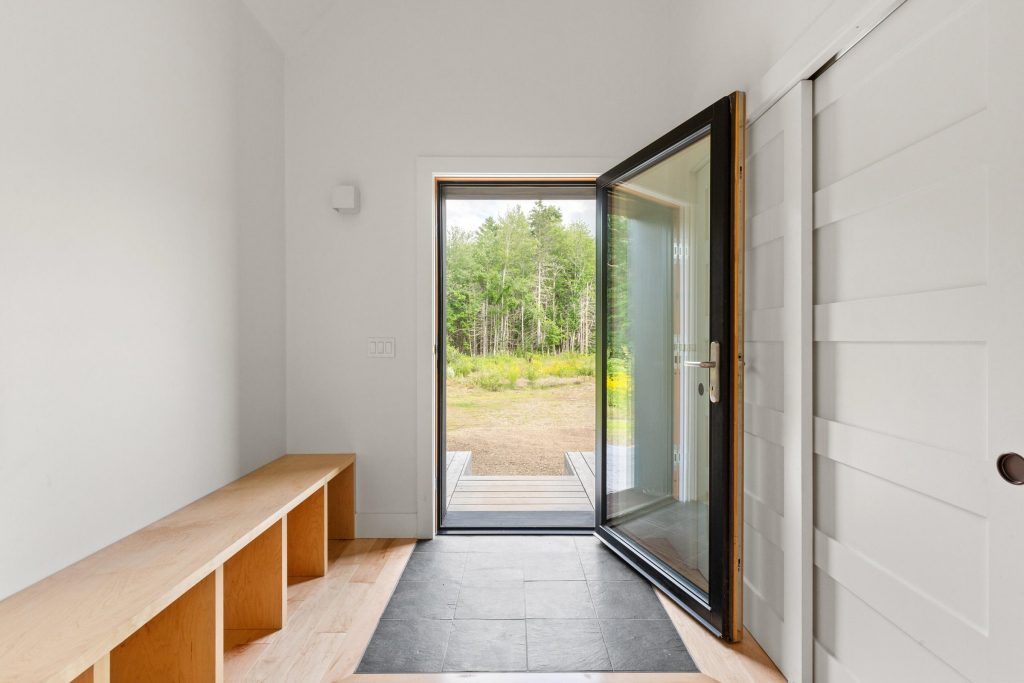“Passive Home” Explained: Understanding Sustainable Design

This stunning energy-efficient new construction built by Ecocor, known as a “Passive House,” has low heating costs and can be net zero energy ready with the addition of solar panels on the metal roof. A Passive House, in simple terms, is the most stringent building energy standard in the world. The southern-facing state-of-the-art 3-bedroom home features Scandinavian-style finishes and is only 10 minutes from Belfast, which was voted “Best Place to Live” in 2022 by Downeast magazine.
A Passive House uses high levels of insulation so that it retains heat efficiently. Combined with airtight, thermal bridge-free construction, triple-glazed windows, and balanced mechanical ventilation, Passive Houses achieve heat loads so low that they are often able to be heated with a small heat pump, for example, and cost very little to heat and cool, even in colder climates like Maine. The concept of the passive home originated in Germany, and designs are certified through the Passive House Institute in Darmstadt, Germany.
Ecocor, based in Searsmont, Maine, makes both customizable, pre-designed homes and custom-designed sophisticated homes built to passive house standards. Chris Corson, the owner of Ecocor, trained in Germany started designing Passive Houses in 2005. In 2014, Ecocor became North America’s first manufacturer of prefab Passive Houses, the first certified Passive House component manufacturer outside of Europe.
Fast forward to 2023 and there are hundreds, if not thousands of outfits building passive homes in the United States and there is a lot more consumer buy-in because of rising energy costs.
From the Ecocor website:
Passive House is the most energy-efficient building standard in the market today. In order to become a certified Passive House, the finished building is tested to ensure that it actually meets its design goals. No other energy standard requires this.
People feel a difference living in an Ecocor Passive House. The filtered fresh air means that our clients experience reduced allergens and regulated humidity levels, leading to improved breathing, sleeping, and better overall health. We believe that quality does not have to be a victim of cost, and that sustainability is no longer simply an option.
“Maine has both the oldest housing stock and the oldest population in the country,” says Annemarie Ahearn, the Camden-based agent representing this Ecocor property. “As fuel costs rise and retired folks on fixed incomes are paying ever greater sums of money annually to heat old, drafty houses, it will be increasingly unaffordable for them to stay put. All of a sudden, the passive home concept no longer seems novel, but rather necessary to establish home maintenance costs that are affordable and predictable.”
“In order to achieve mass adoption,” explains Corson, “a country needs a 5% market buy-in to a concept. While we are not there yet, I believe we are headed in that direction.”

“When I pull into the driveway of 600 Augusta Road in Belmont, a handsome, black home with clean lines and a metal roof stands before me,” says Ahearn. “Surrounded by a 10-acre lot, mostly cleared with forested land to the North, the dark Southern-facing facade absorbed uninterrupted sunlight from dawn to dusk. As the door closed behind me when I entered the home, I was struck by the complete lack of sound. It was silent. This was my first time in a passive home and it felt like I was being let in on a secret, a glimpse of the future.”
All of the Ecocor home models are “net-zero ready” and with the addition of solar panels, can operate with zero carbon footprint. “Solar panels generally run $3/watt and an 1850 square foot home like this one would require anywhere from 4-4.5 KWs depending on whether the homeowner needed to charge an electric car,” explains Ahearn. Ecocor also helps its clients connect with a solar company in the area called Solar Logic.
“While the consumer can attempt to digest the science and engineering of a passive home, what really speaks to people is the annual heating cost figures generated by the utility bills of satisfied customers,” Corson explains. “This 1,850 square foot home will cost no more than $300 a year to heat. And that is without the addition of solar panels.”
Furthermore, Ecocor always opts for high-performance, high-quality appliances that meet the highest energy efficiency standard and advocates for their clients to use induction stovetops.
“While the cost of a finished home may be slightly more than similarly sized homes in the area, which are mostly older homes with low-efficiency standards, the utility savings quickly offset the difference in price,” Ahearn adds. “Another plus is the knowledge that you live in a home with a minimal carbon footprint that will cost relatively little to maintain over time.”
Learn more about Ecocor by visiting its website.
600 Augusta Road, Belmont, Maine
Offered at $699,000
Represented by Annemarie Ahearn
This stunning brand-new energy-efficient home sits on 10 acres of cleared land set far off the road. Just 10 minutes to Belfast and the coast, you can live in a beautifully designed Southern-facing home, with an open floor plan for entertaining, Scandinavian-style finishes, brand-new energy-efficient systems and appliances, and an enormous yard that captures light from morning until evening. The home has low heating costs and can be net-zero energy ready with the addition of solar panels on the metal roof. Learn more about this passive home for sale in Maine here.











